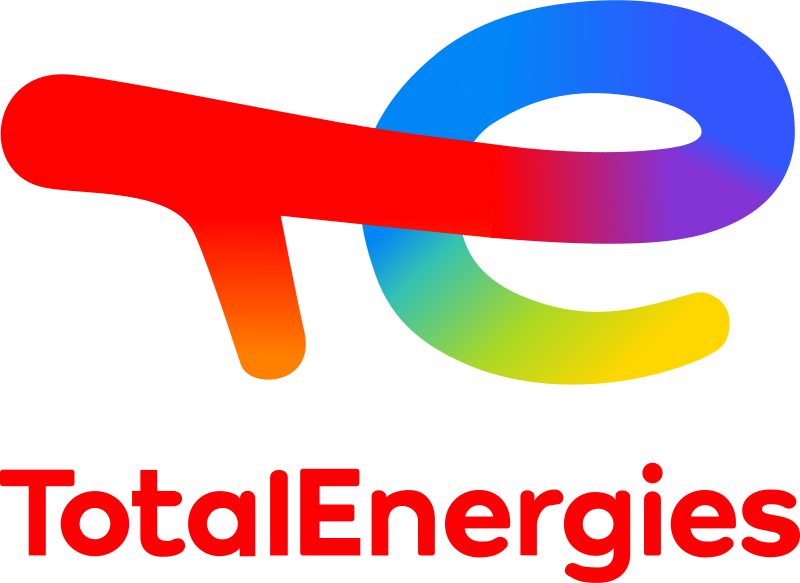Global AI in Energy Market By Offerings, By Application, By Technology, By End Use Industry, By Region & Segmental Insights Trends and Forecast, 2024 – 2034
- Industry: Energy & Power
- Report ID: TNR-110-1279
- Number of Pages: 420
- Table/Charts : Yes
- August, 2024
- Base Year : 2024
- No. of Companies : 10+
- No. of Countries : 29
- Views : 10060
- Covid Impact Covered: Yes
- War Impact Covered: Yes
- Formats : PDF, Excel, PPT
AI technologies are enhancing efficiency, reducing costs, and enabling more sustainable practices across the energy value chain. Artificial Intelligence (AI) first entered the energy market as a tool for improving predictive maintenance and demand forecasting. Initially, its applications were limited to analyzing historical data to anticipate equipment failures and optimize resource allocation. Early AI technologies helped enhance operational efficiency by predicting when maintenance was needed and by improving the accuracy of demand forecasts. As AI technology advanced, with the development of more sophisticated machine learning and deep learning algorithms, its capabilities expanded significantly. The proliferation of Internet of Things (IoT) devices and smart sensors in the energy sector further accelerated this transformation by generating vast amounts of data that AI could analyze to make more informed decisions.
The transition towards renewable energy sources such as wind and solar created new challenges related to energy variability and grid stability. AI played a critical role in addressing these challenges by optimizing the integration of renewable energy into the grid and predicting production levels. The evolution of smart grids, incorporating advanced communication and control technologies, allowed AI to enhance real-time monitoring, fault detection, and automated grid management. Government initiatives and investments in AI research also contributed to this transformation, as policies and incentives supported the adoption of AI technologies in energy systems.
Global AI in energy market has witnessed substantial growth over the past few years, driven by increasing investments in AI technologies and a growing need for energy efficiency. As of 2023, the AI in energy market was valued at approximately USD 10.5 billion and is expected to expand at a compound annual growth rate (CAGR) of 32% from 2024 to 2034.
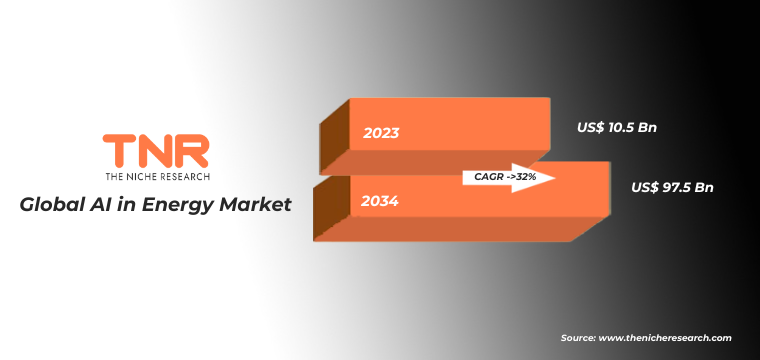
Key Trends: Global AI in Energy Market
- Increased Investment in AI Research: Companies and governments are investing heavily in AI research to drive innovation in the energy sector. This includes funding for startups, partnerships between technology providers and energy companies, and collaborative research initiatives. For instance, The U.S. Department of Energy (DOE) has allocated over USD 100 million in AI research and development for energy systems as part of its AI for Energy initiative. This funding supports collaborative research projects and the development of innovative AI technologies.
- Rise of Smart Grids: According to data from TNR, The Niche Research, the global smart grid market, which relies significantly on AI technologies, is projected to expand from USD 35 billion in 2023 to USD 63 billion by 2028. AI’s role in real-time monitoring and automated control is pivotal in this growth. The deployment of AI in smart grids has led to significant improvements in grid reliability. For instance, Pacific Gas and Electric (PG&E) uses AI algorithms for predictive maintenance and fault detection, resulting in a 30% reduction in power outages.
- AI-Driven Energy Storage Solutions: Advancements in AI are leading to improved energy storage solutions, which are essential for managing the intermittency of renewable energy sources. AI is used to optimize battery performance and enhance energy storage systems. For example, Tesla’s Powerwall and Powerpack systems use AI to optimize battery performance and energy storage. AI algorithms optimize charging and discharging cycles by analyzing real-time energy consumption patterns and grid requirements.
- Integration of AI with IoT: The combination of AI and IoT is transforming the energy sector by enabling more precise monitoring and control of energy systems. IoT devices generate vast amounts of data, which AI algorithms analyze to improve efficiency and decision-making. Companies like Schneider Electric and Siemens are leveraging AI and IoT for enhanced energy management. Schneider Electric’s EcoStruxure platform uses AI to analyze data from IoT sensors, providing insights that improve energy efficiency and system performance.
- Personalized Energy Solutions: AI is enabling the development of personalized energy solutions for consumers. This includes smart home systems that optimize energy usage based on individual preferences and behavior patterns. Google Nest and Amazon Alexa have incorporated AI to create personalized energy solutions for smart homes.
Global AI in Energy Market Challenges: The increased use of AI in energy systems raises concerns about data privacy and security. Safeguarding sensitive data from cyber threats and ensuring adherence to data protection regulations are essential challenges.In addition, the initial cost of implementing AI technologies can be high, particularly for small and medium-sized enterprises. This includes costs related to technology acquisition, system integration, and training. There is a shortage of skilled professionals with expertise in both AI and the energy sector. This gap poses a challenge for companies looking to implement AI solutions effectively.
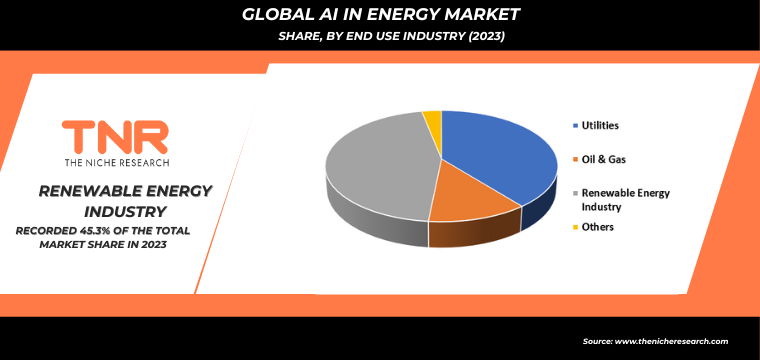
In the global AI in energy market, software/solutions account for a substantial revenue share exceeding 60% in 2023. These solutions include advanced analytics platforms, machine learning algorithms, and decision-support systems that optimize energy production, distribution, and consumption. Predictive maintenance application is a key segment within AI solutions, has transformed how energy companies maintain their equipment. By leveraging machine learning algorithms, these tools predict potential equipment failures before they occur, thereby reducing downtime and maintenance costs. For instance, GE’s Predix platform uses AI to monitor and predict equipment health, contributing to a 20-25% reduction in maintenance costs. The growing adoption of predictive maintenance software illustrates its critical role in achieving operational efficiency and reducing unexpected equipment failures. In addition, energy storage optimization is a significant application of AI software, addressing the challenges associated with renewable energy intermittency. AI algorithms are used to optimize battery performance, manage energy storage systems, and forecast energy needs. For example, Tesla’s Powerwall uses AI to manage battery charging and discharging, improving energy efficiency and storage capacity. The increasing focus on renewable energy storage highlights the crucial role of AI software in enhancing the efficiency and effectiveness of energy storage systems. Furthermore, the development of personalized energy solutions, powered by AI software, is also a notable trend. AI enables the creation of smart home systems that optimize energy usage based on individual preferences and behaviours. Data gathered indicates that the smart home sector, driven by AI, will grow from USD 95 billion in 2024 to USD 188 billion by 2029. AI-driven platforms such as Google Nest and Amazon Alexa use machine learning to tailor energy consumption patterns, offering personalized energy management and contributing to overall efficiency.
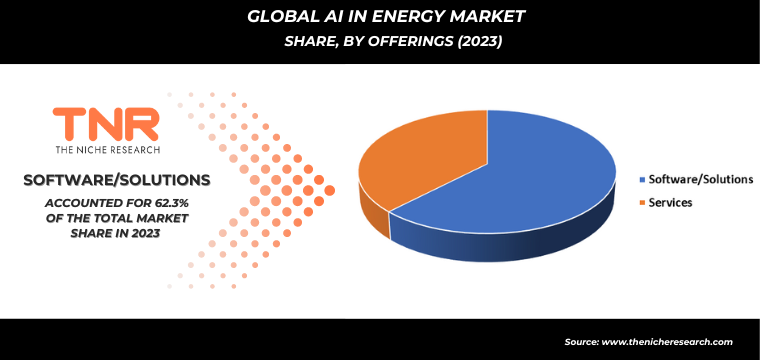
Machine Learning (ML) holds a significant share of AI technology in the energy sector, representing over 55% of the total market revenue in 2023. This dominance underscores the transformative role of ML in optimizing various aspects of energy management. One of the primary applications of Machine Learning (ML) is in predictive maintenance, where ML algorithms analyze data from sensors and historical records to forecast equipment failures before they occur. For example, Siemens’ MindSphere platform, which employs ML, has demonstrated the ability to predict equipment failures with up to 90% accuracy, significantly reducing maintenance costs and unplanned downtime. Additionally, the utility company Enel uses ML-driven predictive maintenance to monitor over 30,000 assets, resulting in a 15% decrease in maintenance costs and improved operational efficiency. Machine learning also improves energy forecasting by predicting both energy consumption and renewable energy production. This capability is essential for integrating renewable sources into the grid and managing energy resources effectively. For example, E.ON in Germany employs ML to forecast energy demand and renewable production, improving its ability to manage resources and integrate renewables.
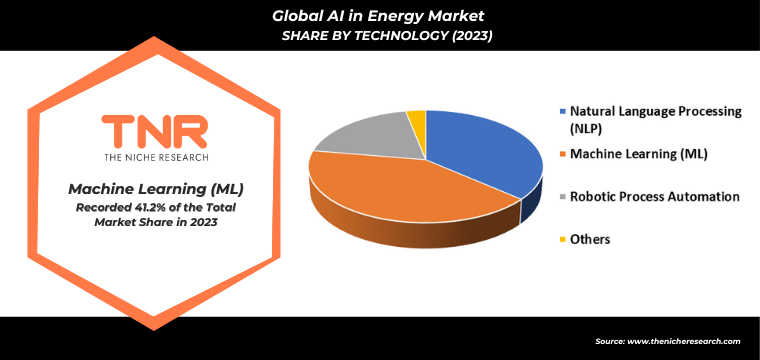
Europe is experiencing significant growth in the AI in energy market, largely fuelled by the transition to renewable energy and robust government initiatives aimed at reducing carbon emissions. It has been predicted that Europe’s investment in renewable energy technologies is set to exceed EUR 100 billion annually by 2025, reflecting the continent’s commitment to sustainable energy solutions. This growth is driven by ambitious targets set by the European Union, such as achieving climate neutrality by 2050, which is supported by policies like the European Green Deal.
Countries such as Germany and France are at the forefront of this transition. Germany’s use of AI technologies in managing renewable energy sources has been pivotal, with companies like Siemens and RWE leveraging AI for grid optimization and predictive maintenance. Siemens’ AI-powered energy management systems have enabled more efficient integration of renewables, contributing to Germany’s goal of a 65% renewable energy share by 2030.
France is also making strides, with significant investments in AI for energy efficiency and smart grid technologies. The French government’s Plan Climat aims to reduce greenhouse gas emissions by 40% by 2030, which is driving demand for AI solutions that enhance energy efficiency and grid reliability. EDF (Électricité de France), for example, utilizes AI to optimize the performance of its renewable energy assets and improve energy storage systems. EDF’s AI-driven energy solutions have led to increased efficiency and better integration of renewable energy into the national grid.
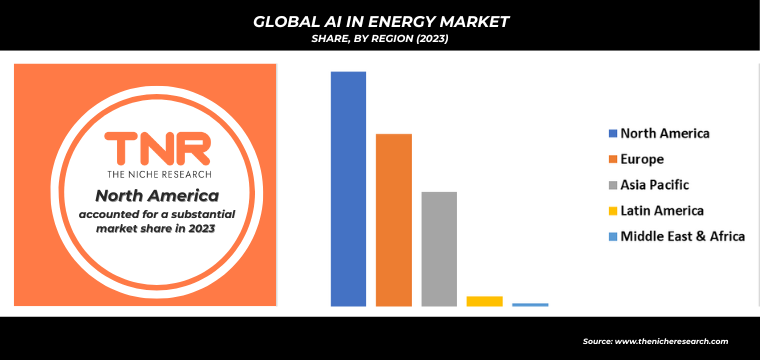
Competitive Landscape: Some of the players operating in the AI in energy market are:
- ABB
- AI Energy Technologies
- AutoGrid Systems, Inc.
- BIDGELY INC
- ai, Inc.
- GE (General Electric Company)
- mPrest
- Siemens AG
- SparkCognition
- Vratatech
- Other Industry Participants
Global AI in Energy Market Scope:
| Report Specifications | Details |
| Market Revenue in 2023 | US$ 10.5 Bn |
| Market Size Forecast by 2034 | US$ 97.5 Bn |
| Growth Rate (CAGR) | 32% |
| Historic Data | 2016 – 2022 |
| Base Year for Estimation | 2023 |
| Forecast Period | 2024 – 2034 |
| Report Inclusions | Market Size & Estimates, Market Dynamics, Competitive Scenario, Trends, Growth Factors, Market Determinants, Key Investment Segmentation, Product/Service/Solutions Benchmarking |
| Segments Covered | By Offerings, By Application, By Technology, By End Use Industry |
| Regions Covered | North America, Europe, Asia Pacific, Middle East & Africa, Latin America |
| Countries Covered | U.S., Canada, Mexico, Rest of North America, France, The UK, Spain, Germany, Italy, Nordic Countries (Denmark, Finland, Iceland, Sweden, Norway), Benelux Union (Belgium, The Netherlands, Luxembourg), Rest of Europe, China, Japan, India, New Zealand, Australia, South Korea, Southeast Asia (Indonesia, Thailand, Malaysia, Singapore, Rest of Southeast Asia), Rest of Asia Pacific, Saudi Arabia, UAE, Egypt, Kuwait, South Africa, Rest of Middle East & Africa, Brazil, Argentina, Rest of Latin America |
| Key Players | ABB, AI Energy Technologies, AutoGrid Systems, Inc., BIDGELY INC, C3.ai, Inc., GE (General Electric Company), mPrest, Siemens AG, SparkCognition, Vratatech, Other Industry Participants |
| Customization Scope | Customization allows for the inclusion/modification of content pertaining to geographical regions, countries, and specific market segments. |
| Pricing & Procurement Options | Explore purchase options tailored to your specific research requirements |
| Contact Details | Consult With Our Expert
Japan (Toll-Free): +81 663-386-8111 South Korea (Toll-Free): +82-808- 703-126 Saudi Arabia (Toll-Free): +966 800-850-1643 United Kingdom: +44 753-710-5080 United States: +1 302-232-5106 E-mail: askanexpert@thenicheresearch.com
|
Global AI in Energy Market
By Offerings
- Software/Solutions
- Services
By Application
- Smart Grids
- Demand Response Management
- Predictive Maintenance
- Renewable Energy Forecasting
- Energy Storage Management
- Carbon Capture, Utilization, And Storage (CCUS)
- Emission Tracking
- Energy Trading
- Smart Homes And Buildings
- Digital Twins
- Oil And Gas Exploration
- Nuclear Power Plant Monitoring
- Others
By Technology
- Natural Language Processing (NLP)
- Machine Learning (ML)
- Robotic Process Automation
- Others
By End Use Industry
- Utilities
- Oil & Gas
- Renewable Energy Industry
- Others
By Region
- North America (U.S., Canada, Mexico, Rest of North America)
- Europe (France, The UK, Spain, Germany, Italy, Nordic Countries (Denmark, Finland, Iceland, Sweden, Norway), Benelux Union (Belgium, The Netherlands, Luxembourg), Rest of Europe)
- Asia Pacific (China, Japan, India, New Zealand, Australia, South Korea, Southeast Asia (Indonesia, Thailand, Malaysia, Singapore, Rest of Southeast Asia), Rest of Asia Pacific)
- Middle East & Africa (Saudi Arabia, UAE, Egypt, Kuwait, South Africa, Rest of Middle East & Africa)
- Latin America (Brazil, Argentina, Rest of Latin America)
Report Layout:
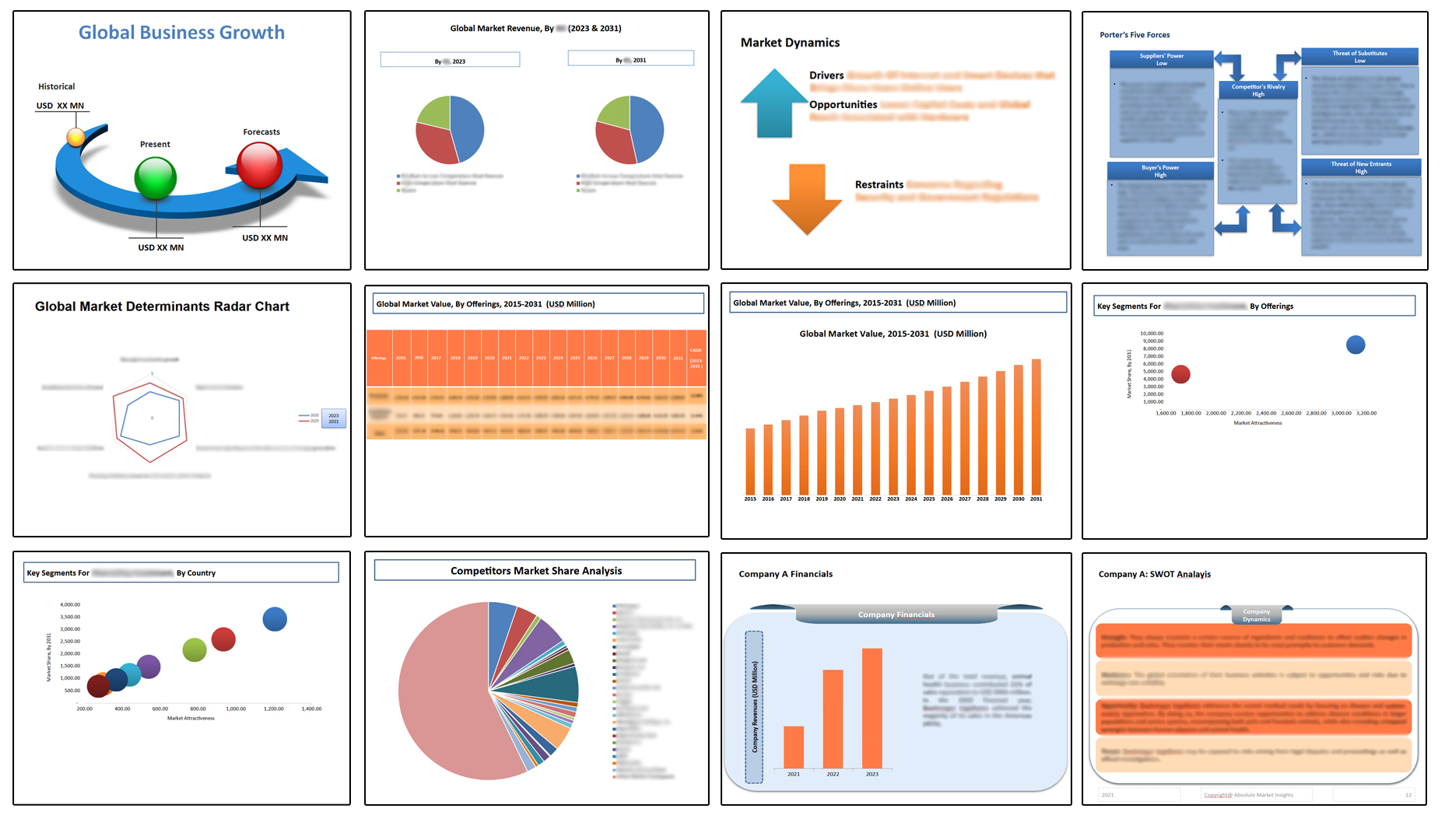
Table of Contents
Note: This ToC is tentative and can be changed according to the research study conducted during the course of report completion.
**Exclusive for Multi-User and Enterprise User.
Global AI in Energy Market
By Offerings
- Software/Solutions
- Services
By Application
- Smart Grids
- Demand Response Management
- Predictive Maintenance
- Renewable Energy Forecasting
- Energy Storage Management
- Carbon Capture, Utilization, And Storage (CCUS)
- Emission Tracking
- Energy Trading
- Smart Homes And Buildings
- Digital Twins
- Oil And Gas Exploration
- Nuclear Power Plant Monitoring
- Others
By Technology
- Natural Language Processing (NLP)
- Machine Learning (ML)
- Robotic Process Automation
- Others
By End Use Industry
- Utilities
- Oil & Gas
- Renewable Energy Industry
- Others
By Region
- North America (U.S., Canada, Mexico, Rest of North America)
- Europe (France, The UK, Spain, Germany, Italy, Nordic Countries (Denmark, Finland, Iceland, Sweden, Norway), Benelux Union (Belgium, The Netherlands, Luxembourg), Rest of Europe)
- Asia Pacific (China, Japan, India, New Zealand, Australia, South Korea, Southeast Asia (Indonesia, Thailand, Malaysia, Singapore, Rest of Southeast Asia), Rest of Asia Pacific)
- Middle East & Africa (Saudi Arabia, UAE, Egypt, Kuwait, South Africa, Rest of Middle East & Africa)
- Latin America (Brazil, Argentina, Rest of Latin America)
The Niche Research approach encompasses both primary and secondary research methods to provide comprehensive insights. While primary research is the cornerstone of our studies, we also incorporate secondary research sources such as company annual reports, premium industry databases, press releases, industry journals, and white papers.
Within our primary research, we actively engage with various industry stakeholders, conducting paid interviews and surveys. Our meticulous analysis extends to every market participant in major countries, allowing us to thoroughly examine their portfolios, calculate market shares, and segment revenues.
Our data collection primarily focuses on individual countries within our research scope, enabling us to estimate regional market sizes. Typically, we employ a bottom-up approach, meticulously tracking trends in different countries. We analyze growth drivers, constraints, technological innovations, and opportunities for each country, ultimately arriving at regional figures.Our process begins by examining the growth prospects of each country. Building upon these insights, we project growth and trends for the entire region. Finally, we utilize our proprietary model to refine estimations and forecasts.
Our data validation standards are integral to ensuring the reliability and accuracy of our research findings. Here’s a breakdown of our data validation processes and the stakeholders we engage with during our primary research:
- Supply Side Analysis: We initiate a supply side analysis by directly contacting market participants, through telephonic interviews and questionnaires containing both open-ended and close-ended questions. We gather information on their portfolios, segment revenues, developments, and growth strategies.
- Demand Side Analysis: To gain insights into adoption trends and consumer preferences, we reach out to target customers and users (non-vendors). This information forms a vital part of the qualitative analysis section of our reports, covering market dynamics, adoption trends, consumer behavior, spending patterns, and other related aspects.
- Consultant Insights: We tap into the expertise of our partner consultants from around the world to obtain their unique viewpoints and perspectives. Their insights contribute to a well-rounded understanding of the markets under investigation.
- In-House Validation: To ensure data accuracy and reliability, we conduct cross-validation of data points and information through our in-house team of consultants and utilize advanced data modeling tools for thorough verification.
The forecasts we provide are based on a comprehensive assessment of various factors, including:
- Market Trends and Past Performance (Last Five Years): We accurately analyze market trends and performance data from preceding five years to identify historical patterns and understand the market’s evolution.
- Historical Performance and Growth of Market Participants: We assess the historical performance and growth trajectories of key market participants. This analysis provides insights into the competitive landscape and individual company strategies.
- Market Determinants Impact Analysis (Next Eight Years): We conduct a rigorous analysis of the factors that are projected to influence the market over the next eight years. This includes assessing both internal and external determinants that can shape market dynamics.
- Drivers and Challenges for the Forecast Period:Identify the factors expected to drive market growth during the forecast period, as well as the challenges that the industry may face. This analysis aids in deriving an accurate growth rate projection.
- New Acquisitions, Collaborations, or Partnerships: We keep a close watch on any new acquisitions, collaborations, or partnerships within the industry. These developments can have a significant impact on market dynamics and competitiveness.
- Macro and Micro Factors Analysis:A thorough examination of both macro-level factors (e.g., economic trends, regulatory changes) and micro-level factors (e.g., technological advancements, consumer preferences) that may influence the market during the forecast period.
- End-User Sentiment Analysis: To understand the market from the end-user perspective, we conduct sentiment analysis. This involves assessing the sentiment, preferences, and feedback of the end-users, which can provide valuable insights into market trends.
- Perspective of Primary Participants: Insights gathered directly from primary research participants play a crucial role in shaping our forecasts. Their perspectives and experiences provide valuable qualitative data.
- Year-on-Year Growth Trend: We utilize a year-on-year growth trend based on historical market growth and expected future trends. This helps in formulating our growth projections, aligning them with the market’s historical performance.
Research process adopted by TNR involves multiple stages, including data collection, validation, quality checks, and presentation. It’s crucial that the data and information we provide add value to your existing market understanding and expertise. We have also established partnerships with business consulting, research, and survey organizations across regions and globally to collaborate on regional analysis and data validation, ensuring the highest level of accuracy and reliability in our reports.









